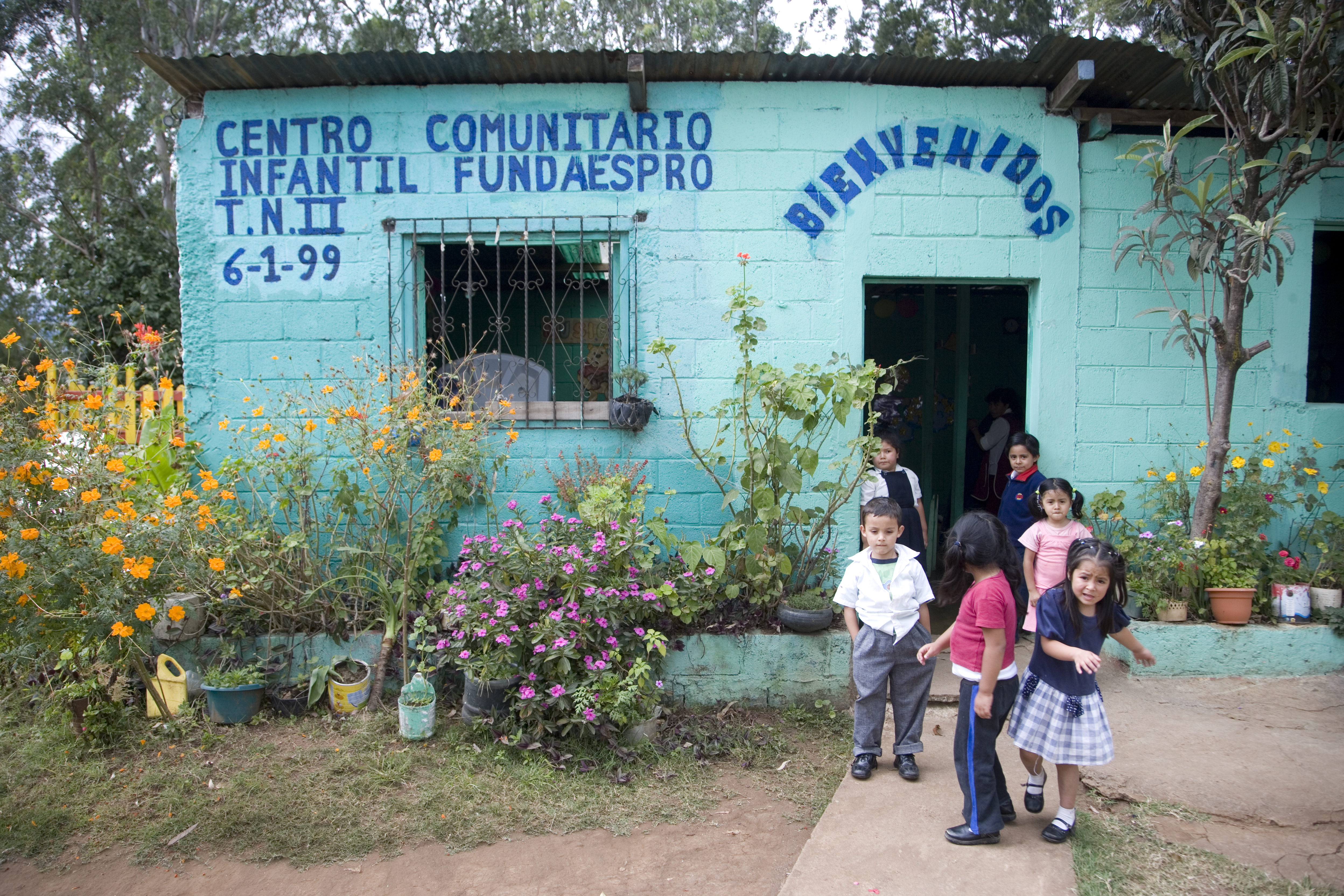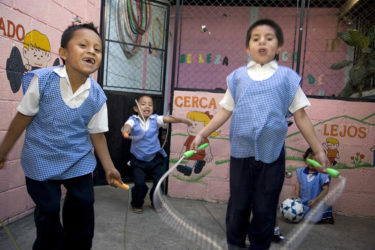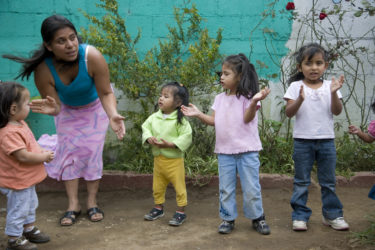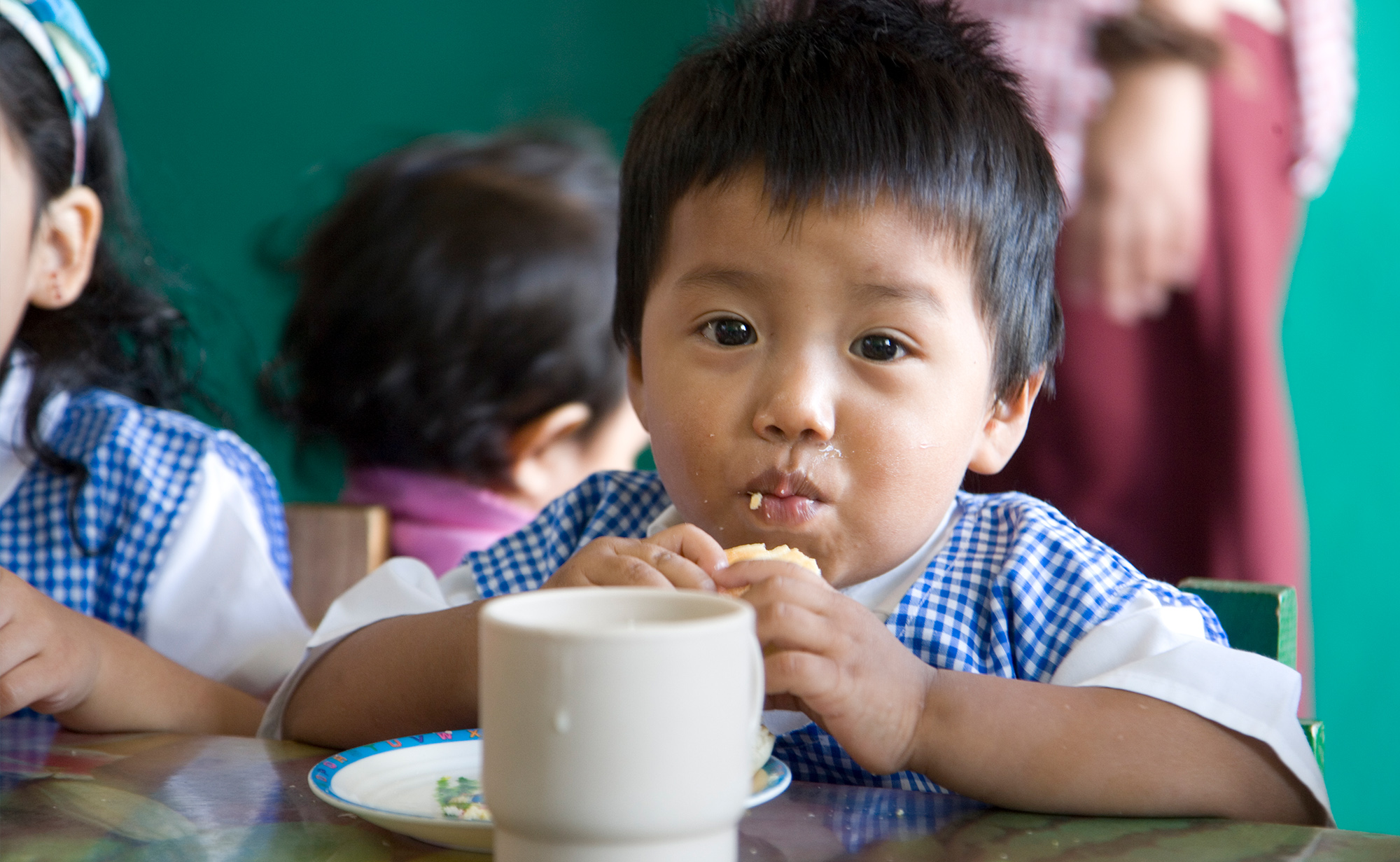Roots of change
How a Guatemalan grassroots women’s organisation creates holistic child-centred communities, one neighbourhood at a time
Bernard van Leer Foundation Historical Cases
We commissioned narrative case studies of several countries in which we previously had a long-term presence. Though making the transition to scale was not then an explicit aim, we wanted to see what we could learn from these experiences to inform our scale-focused partnerships today.
FOREWORD
From 1990 to 2008, the Bernard van Leer Foundation funded FUNDAESPRO (Fundación Esfuerzo y Prosperidad, or Strength and Prosperity Foundation), a grassroots women’s organisation in Guatemala City. Our involvement started at a time when the civil war drove refugees from rural areas, and the government – not wanting to encourage more migration – made little effort to provide basic services. Unemployment and violence were rife.
As you will read in the coming pages, the organisation not only pioneered a community-based model for early childhood development, but also grew into an organisation that today has local chapters in 126 neighbourhoods. Beyond service delivery, its leaders have routinely been consulted by government on policies relating to children’s rights, elements of its curriculum were adopted for publicly provided childcare centres, and other non-governmental organisations in Guatemala have been influenced by its philosophy and practices.
All this said, Guatemala remains a challenging country for families, with the region’s highest rate of child malnutrition and lowest level of public spending on education, raising the question: what else could the Foundation have done during its engagement in the country to help the work and ideas of FUNDAESPRO spread even further?
I am most grateful to Ms Olga Hernández for her support to the author, Jean Friedman-Rudovsky. Also, to our programme officer at the time, Marc Mataheru, for his valuable guidance and recollections. My own learning questions after reading this piece are shared at the end.
Michael Feigelson, Executive Director, Bernard van Leer Foundation, August 2018
Guatemala
- Period:1992-2008
- Total Bernard van Leer Foundation investment in Guatemala: EUR 3,000,000 – EUR 187,500/year
PART ONE
The La Verbena neighbourhood of Guatemala City occupies an area ten blocks square, just west of downtown. The main entrance to the colonia, which runs along a busy avenue, has tall walls and the gate, although allowing free access, is under constant watch. Directly to the north of the neighbourhood sits a cemetery. Most of the residents’ homes are on a steep slope, cascading downwards precariously towards one of the city’s main landfills.
In 1993, the last time Guatemala did a census count, La Verbena had 25,000 occupants. Current estimates put it at over 40,000. The average home is made up of multiple generations; mothers are more likely to be single than not. Although the neighbourhood is no longer under the control of the notorious Mara Salvatrucha gang, as it was during the 1990s, La Verbena’s high unemployment rate and poverty level mean that teenagers are still easily lured into gangs. The area has recently been referred to as ‘a haven’ for hit men.
None of this makes La Verbena particularly exceptional, in a city which primarily comprises small sections of impoverishment and crowded living conditions. What does make La Verbena unique, however, is a small group of people within the community pushing back to ensure that the future of this neighbourhood and many others like it doesn’t follow the path of the typical Guatemalan urban story.
Upon entering La Verbena, evidence of the presence of this strong community organisation is noticeable. On any given morning, right inside the border along the avenue lined with walls, you can see approximately 30 toddlers climbing on brightly painted playground equipment and throwing balls around a concrete courtyard. Their play area is situated directly between their classroom space and a bright blue medical clinic that houses a pharmacy, a blood lab, a dentist’s office and a doctor’s consultation area, providing services and products to La Verbena’s residents at a nominal cost.
These facilities were established mainly due to the efforts of a group of La Verbena residents who are part of a city-wide women’s organisation known as FUNDAESPRO (‘Fundación Esfuerzo y Prosperidad’, or Strength and Prosperity Foundation). Founded in 1989 by female community health workers living in marginalised areas, the group aimed to carry out advocacy and service work to improve the lives of the city’s most vulnerable populations. Over the past three decades, they have formed local chapters in 126 neighbourhoods, with each group deciding for itself what kinds of projects and issues it will prioritise, depending on the needs of the families living in that area.
Early on, FUNDAESPRO’s founders realised that children’s rights and early childhood development would be a cornerstone of their work, and they started to receive funding and support from the Bernard van Leer Foundation. In this alliance with the Foundation, FUNDAESPRO initiated more than a dozen childcare centres in the city’s most needy neighbourhoods and led important political organising efforts.
There is a plethora of civil society organisations dedicated to the well-being of children. In part that’s because this is an area that the government traditionally neglects. Guatemala invests less in education than any other Central American country: it hovers between 1.6% and 2.5% of GDP in recent years. Early childhood development receives scant direct government attention, with only 1% of the nation’s preschool-age children attending educational programmes. According to Magali García, who until recently worked for the Organization of American States in Guatemala, ‘early childhood development is not a governmental priority in this country.’
But, over the course of several days in Guatemala City, I learned that in this crowded landscape, FUNDAESPRO stands out. ‘There are a lot of us who do work with children, either through direct service or advocacy in other spaces but not necessarily from a base in the community and from the perspective of prevention as FUNDEASPRO does,’ says Miguel Ángel López, Executive Director of CONACMI, Guatemala’s National Association Against Child Abuse.
Indeed, it seems that FUNDAESPRO has come to be known as the premier community-based advocacy organisation for the rights of children in the city, and perhaps in the nation. Its hallmark is its grassroots approach and its ability to establish not just high-quality childcare centres, but neighbourhood-based programmes that offer a range of services supporting holistic and healthy development for the city’s youngest. And, as it turns out, it’s hard to see how the organisation could have gained its strength were it not for the Bernard van Leer Foundation’s support.
PART TWO
Guatemala’s civil war between leftist insurgents and repressive government forces, which lasted from 1960 to 1996, triggered one of the largest internal migrations the Americas had seen to date. During the 1970s and 1980s, the state unleashed a brutal campaign targeting the Mayan highlands, prompting a mass rural–urban exodus. More than 1,000,000 Guatemalans are estimated to have been displaced.
Most of the refugees headed towards Guatemala City. The city swelled suddenly and without adequate preparation: the new migrants squatted on land with no access to potable water, electricity or medical care. The Guatemalan government reacted with what seemed like a policy of intentional abandonment. ‘The government did not want to encourage more migration,’ says Julio Cano, a professor and economist in Guatemala City. He says that rather than providing assistance to the new residents and establishing services that would make the refugees’ new living area more habitable, the authorities did almost nothing at all.
The hope that this would inhibit more people from arriving didn’t pan out: Guatemala city’s population exploded as the war raged on. The lack of attention being paid by the state to the humanitarian crisis unfolding in the new slums prompted international aid agencies to scramble to fill in the gaps. Of all the concerns about people’s welfare in the new areas, health rose to the top, with multiple programmes being put into operation to stem illness and infection. In 1986, Doctors without Borders began training legions of community health workers; local women, often with no formal education, were taught how to administer IVs, treat skin irritations or respiratory infections, and educate their neighbours on reproductive health and the basics of good hygiene and nutrition.
In 1989 a handful of these women, known as ‘Reproinsas’ (Representatives of the Integrated Health Programme), living in the Plaza del Toros neighbourhood, started discussing the potential of doing something together beyond administering health aid. ‘We were in a place where minimum basic services necessary to sustain life were absent,’ recalls Olga Hernández, a founder of FUNDAESPRO and its current General Coordinator of Projects. ‘The origins of FUNDAESPRO were rooted in the inhumane conditions we lived in.’
In 1989 a handful of these women, known as ‘Reproinsas’ (Representatives of the Integrated Health Programme), started discussing the potential of doing something together beyond administering health aid.
Hernández was clear that it should be a women’s organisation. ‘It is women who suffer more in situations like these because we are the ones who are in charge of the household,’ she told me, and their initial mission was to lobby for better living conditions in marginalised urban areas, and for health improvement projects specifically. But soon after its founding FUNDAESPRO realised that there was perhaps nothing more important than trying to safeguard the well-being of their community’s children. Hernández recalls: ‘When there isn’t potable water, when there aren’t sewage systems, we witness great sickness. Children were dying every day. That’s when we realised we had to work on childhood welfare and development. These were our kids, our neighbours’ kids. All of this was happening in our own communities.’
The origins of FUNDAESPRO, founded in 1989, were rooted in the inhumane conditions we lived in.
Their first tangible project concerning children was simple: to provide a midday meal for the kids whose parents disappeared for long hours to work in low-paid jobs in other parts of the city. With space borrowed from a local church in Plaza de Toros, Hernández and other women would prepare atole (a nutritious corn-based drink) and offer it to any child who showed up. That’s when ‘we saw something really interesting happen,’ Hernández told me. ‘The kids showed up for food but they stayed because they liked the environment. It was a nicer place for them to be than in their homes all day, which were overcrowded and chaotic. With us they could play and feel safe.’
FUNDAESPRO had secured financial support from Unicef and in 1990, around the time that the organisation was working on its non-profit status in Guatemala, the group made the connection with the Bernard van Leer Foundation. FUNDAESPRO was eager to expand and develop its work with children. It wanted to mature its programming from simply providing a safe space for kids to offering real educational opportunity to the children in the city’s vast slums, with staffing by community members themselves. The Bernard van Leer Foundation was intrigued by the idea: they wanted to support early childhood programmes for vulnerable urban communities and FUNDAESPRO’s commitment to advocacy was aligned with the Foundation’s goals to influence the debate and policies on social programmes in Guatemala with a focus on children. The Foundation decided to fund FUNDAESPRO: from 1990 to 1996 the grants went through Unicef; from 1996 to 2008 they were made directly to the local organisation.

Preschool nursery for children aged between 2 and 6. Guatemala City. Jon Spaull/Bernard van Leer Foundation
Hernández credits the Bernard van Leer Foundation with being the most influential external element of their development as an organisation. She said that the Foundation’s expertise in early childhood development and curricular models, and their ability to connect FUNDAESPRO to other organisations in Central America striving for the same goals, were key to helping the organisation develop its childcare programming with best practices – including play-based learning and a stimulative curriculum – at its root.
But the Foundation’s significance for FUNDAESPRO is as much about what they didn’t do as it is about what they did. Hernández told me: ‘Van Leer did not impose a model that we were told to follow. They accompanied us on our own path. I think this is one of the biggest accomplishments of [the Foundation]: supporting processes that come from and are directed by the community, and that are not driven by the international agency.’ Also important, says Hernández, was the fact that the Foundation didn’t insist on funding one particular service, as many in the aid world do. They cared about helping the organisation mature. ‘Van Leer wasn’t about project-based funding. They believed in the power of community organising and that enabled us to become strong over time,’ she says.
With the core financial support and flexibility offered by the Bernard van Leer Foundation, FUNDAESPRO became a strong, large and capable organisation – and one that has grown since the Foundation left the region in 2008. FUNDAESPRO is now in 126 neighbourhoods; in each area, there is a cohort of local women who work with the organisation’s staff (numbering 40) to do a thorough needs assessment of their area in order to establish a plan for which programmes to develop and how. ‘We’re not just talking about focus groups,’ says Hernández. If there are 50 homes in a neighbourhood, she says, they go into every single one, getting to know the families personally: ‘to understand their reality. From this assessment, we are able to understand the situation of each individual family and the community as a whole. Based on this, we design work plans with the community itself and discuss where resources should go, depending on which are the most vulnerable groups in the community.’
PART THREE
On the morning I visited La Verbena, the medical clinic was already in full swing. Inside, towards the front end of the single-story concrete building, a group of young medical students stood in a semicircle, listening in as the doctor starting looking into the ears and mouth of a child, probably around the age of 3, who had come in with a bad cold. Down the hall in the lab, which is equipped to process blood samples and carry out urine and stool tests, María Teresa Chacón, a Reproinsa, was showing Gisela Vásquez, a 24-year-old medical student from San Carlos University, how to spin down the blood she’d just taken from an elderly man seated in the waiting area. Across from the lab, pharmacist Rosa Plata Escobar – a Reproinsa who hadn’t completed schooling past the sixth grade when she did her pharmaceutical training with other FUNDAESPRO members – was selling her first paracetamol of the day.
Although it might not seem exceptional, it is unusual to find a health clinic of this sort inside a neighbourhood like La Verbena. Most of the time, medical services are located in central parts of the city and not inside the neighbourhoods that need them most. Were it not for this clinic, for example, the closest medical centre to La Verbena would be at least 40 minutes away.
What allows this to function is the unique staffing model that FUNDAESPRO established: Reproinsas (pharmacy, lab and nursing), medical professionals (the physician and dentist) and a rotating cohort of medical students who spend four months at a time working in the facility for no fee. Early on, FUNDAESPRO set up a relationship with San Carlos University to bring students into their neighbourhood medical centres. It’s a win–win programme: community medical clinics get staffing assistance they desperately need; the medical schools can offer their students opportunities for valuable experience in the real world. ‘I’m glad I was assigned here,’ Vásquez, the lab student, told me. It was her first week but she already knew it would be a valuable experience. ‘You learn more here than in large hospitals. In hospitals, all you’re doing is shuffling lab results back and forth. Here, we help with interpreting the results.’
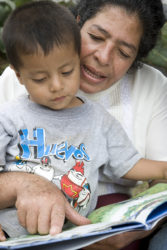
The head of Preschool nursery with some of the children. Guatemala City. Jon Spaull/Bernard van Leer Foundation.
Reproinsas receive a small stipend, and can put their valuable skills to use. The doctor and dentist are the only ones who receive a full salary. This enables the clinic to provide services at a nominal cost: the equivalent of about 1 euro for a blood test or routine exam, a few cents for a package of basic medicines.
Geographic proximity was also behind the vision for the childcare centres – having them in the community rather than taking children out. While this sounds glaringly logical, in Guatemala it’s more the exception than the rule, says María Elvira Sánchez, who leads an NGO named ISMUGUA (‘Instituto para la Superación de la Miseria Urbana de Guatemala’, the Institute for Overcoming Urban Poverty in Guatemala). What makes FUNDAESPRO unique and effective, she told me, is that the organisation ‘locates its services where they are actually needed. The child is not removed from his or her environment. When you take kids out of these areas, it implies a condemnation of their own living spaces, which is harmful to a child. Keeping them in their community, where their families are then part of their educational upbringing, is very important.’
Not having to travel long distances to drop off her son is a huge benefit, says Claudia Flores, whose son attends the FUNDAESPRO daycare centre in La Verbena. She’s also appreciative of the price: just 35 quetzals monthly (about 4 euros). She had been paying 400 for a sitter – close to a third of her total earnings – plus food, but that was unsustainable. She’s very pleased too with the education he gets. ‘My son was slow to develop, it took him long time to learn to write and he was antisocial,’ Flores told me. The school and FUNDAESPRO helped him through these challenges by visiting the home, connecting him with a psychologist and providing personalised attention in the classroom. ‘Now he’s a thriving 5 year old. He’s so happy there that I don’t want him to keep getting older because that means at some point he’ll have to leave[for primary school],’ she told me.
The sort of individualised attention that Flores’ son received is not uncommon, says Hernández. The thorough groundwork that’s laid by local FUNDEASPRO members, when they begin working in a community (through home visits, needs assessments, relationship building) proves critical for other parts of a child’s life. For example, teachers know which of their students don’t yet have an identity card, which is needed to enter primary school. The FUNDAESPRO network will help that child’s parents navigate the bureaucratic system to make sure the child has what he or she needs.
What makes FUNDAESPRO unique and effective is that the organisation locates its services where they are actually needed. The child is not removed from his or her environment. – María Elvira Sánchez
Also, the close relationship between the teachers – who are FUNDAESPRO members trained on an eight-month community educator course formerly funded by the Bernard van Leer Foundation – means that it’s easier for teachers to approach parents when they see worrying changes in a child. Isabel Martínez, one of two educators in La Verbena, told me about a child who was doing very well in his first year with them: he ate well, washed his hands, and was developing on a par with other children his age. Over the summer, when school was out, he slid backwards. When he returned in the autumn, he had forgotten a lot of the lessons he’d learned, didn’t want to eat and his hygiene was poor. Martínez visited the child’s home and spoke with the mother. It turned out she was going through a severe depression and all summer long had not had the emotional energy to engage with her son. She sat him in front of the television and rarely cooked. Martínez was able to put them both in touch with psychologists and the child has now bounced back almost completely, she said.
The therapy element is new to FUNDAESPRO’s work and to La Verbena and it is part of the organisation’s development since the involvement of the Bernard van Leer Foundation. After the Foundation’s exit, Hernández sought other key allies and found it with InterRed, which allowed them to continue their work with children. Currently, it develops the Community Strengthening Project CONVIVIMOS, led by Mercy Corps and funded by USAID. This programme seeks to address the causes and consequences of violence through participation and community strengthening with vulnerable populations, engaging specifically with family support and young people at risk – which is a phrase that could describe most young people in this city. Bringing in psychology students to work with these groups is a part of the new programme.
On the day I visited La Verbena, there were five psychology students beginning their rounds. They said they expected to encounter resistance because in Guatemala there is often a stigma that only ‘crazy’ people need therapy, but FUNDAESPRO has laid the groundwork well. Through the existing monthly family workshops that the organisation has hosted for decades, with parents and with the community at large, FUNDAESPRO members had explained the roots of trauma, the wide range of mental health issues that may be encountered, as well as the potential benefits of professional help.
The psychologists work with adults and children. For the latter, they carry out personalised interventions when teachers or others bring cases to their attention. They also visit the classrooms weekly to observe the kids in order to detect any problems that others may have been overlooking. ‘I love the psychologists,’ Rosa Gonzáles, a mother with two kids in La Verbena’s childcare centres, told me. ‘I’ve seen changes in my kids. They are much more expressive with their feelings and more communicative at home,’ she said. ‘Thanks to the psychologists, now when they get home from school they show me their drawings and say to me “this is the picture I drew and this is how it reflects what I’m feeling”.’
This kind of institutionalised holistic programming is another important element of FUNDAESPRO’s strategy, says Sonia Reyes, who works at ‘Hogares Comunitarios’, the programme within SOSEP (Secretaría de Obras Sociales, the Secretariat of Social Works), the governmental agency for children’s welfare that is housed in the office of the First Lady. Reyes says that while she sees other schools or an organisation seek out the help of a therapist on an ad hoc basis, this kind of core and sustained support is novel and effective. ‘This level of systematisation is what’s impressive,’ she told me, ‘FUNDAESPRO has really sought out sustainable alliances and support that will strengthen children on a deep level.’
The childcare centre itself also still runs on partnerships, with SOSEP in particular. The relationship with SOSEP began in the 1990s when the post-war government sought to create some state-supported early childhood programming. The model has remained largely unchanged since it began almost 30 years ago: SOSEP itself runs some childcare centres, but mainly it offers some base support for others that are already in the community. In the case of FUNDAESPRO’s 13 centres, SOSEP provides the food and drink for the children, gas for cooking, a minimal amount of curricular materials and a stipend of 1400 quetzals (about 160 euros) for the educators. (During the time of the Foundation’s support, FUNDAESPRO was able to give their educators an additional stipend on top of the government payment. I was told by teachers that this no longer occurs.)
We want to transform children and the future by supporting the development of young kids in such a way that they have a desire to return to where they grew up.
– Olga Hernández
The centres themselves are characteristically ‘van Leer’: happy children being engaged and respected. The teachers were trained in child-centred learning and their activities in the classrooms all focus on the formation of good values, critical thinking skills and play-based learning. Although there hasn’t been rigorous research or tracking of the long-term outcomes of the kids who attend FUNDAESPRO centres, anecdotally the organisation is known for preparing the children exceptionally well. ‘The kids who are provided early education by FUNDAESPRO head to primary school with a lot of knowledge,’ ISMUGUA’s Sánchez told me. ‘They enter with a foundation that allows them to move through the rest of their education more easily. These students adapt well and there are many fewer cases of needing to repeat further grades.’ Hernández is proud, of course, of these individual outcomes. But she says that her long-term goal with the holistic work in places like La Verbena is not just to lift up some children so that they can break out and get ahead, but also to transform communities. ‘There was a recent study that found that most kids in neighbourhoods like these want to leave as soon as they have the chance,’ Hernández told me. ‘What we want to do is upend this reality. We want to transform children and the future by supporting the development of young kids in such a way that they have a desire to return to where they grew up in order to keep the process going – and that their neighbourhoods improve over time so they feel worthy of this return.’
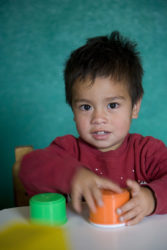
Preschool nursery for children aged between 2 and 6. Guatemala City. Jon Spaull/Bernard van Leer Foundation
FUNDAESPRO’s impact extends far beyond its work in La Verbena and the other neighbourhoods where there are women organisers and programming. From its founding, FUNDAESPRO perceived itself as an advocacy organisation. Hernández told me that she and the other founders knew that in order to create lasting change they had to do more than provide direct services.
Over time, their macro-level impact has advanced in two ways: it has been through the organisation’s involvement in and leadership of inter-institutional networks and government commissions for almost three decades. It seems Hernández and her team have been involved in almost every major policy proposal and decision by the government with regard to children’s rights since the mid-1990s: the Committee for the Rights of the Child, the law of holistic child protection, the law against sexual exploitation and violence, the national permanent forum on health (foro permanente de salud), the (now defunct) Network of Social Movements, the Adoption Law. Most recently they have been key players in the national Child Network, ‘Red Niño a Niño’, an alliance made up of the 30 leading organisations doing work on children’s rights and considered the most central civil society alliance for child welfare and development advocacy. This network does everything from advocating for more child-centred policies to increasing government accountability by monitoring the progress of Millennium Goals, to tracking state expenditure in relation to its budgetary promises on this issue.
When I visited Guatemala, a string of high-level child welfare advocates there showered praise on Hernández and FUNDAESPRO, recounting many instances when she and the organisation’s work had proved pivotal in advancing the rights of children in Guatemala. ‘FUNDAESPRO is a force in the social movement sector,’ said Gloria Castro, the Ombudsman for Children and Youth (Defensora de la Niñez y la Adolescencia), in the Human Rights Office (Procuraduría de los Derechos Humanos). ‘They are one of the most important and strategic organisations for this kind of work.’
In part, I was told, Hernández herself is a terrific advocate and ambassador for the work. ‘She is very active and dynamic, but at the same time conciliatory,’ said CONACMI’s Miguel Ángel López, adding that her ability to be both lighthearted and also very serious is ‘one of her most valuable contributions’. He said he had been in numerous meetings in which Hernández had played a key role in helping the group come to an agreement. ‘She’s always able to lighten the mood with a joke, which helps everyone relax. Then she has a proposal and tries to mediate and find points of consensus,’ he said.
FUNDAESPRO’s macro-impact has not only been through its political advocacy. The organisation has been able to influence large-scale change by positioning itself as an entity with replicable best practices. For example, when FUNDAESPRO first started working with state programme Hogares in the early 1990s, the government’s only curricular materials for the community educators were a set of rudimentary manuals with graphic drawings. Part of the agreement between SOSEP and FUNDAESPRO was to align the educational materials, and what SOSEP found was that FUNDAESPRO’s materials were better: simple yet dynamic exercises that could be used with a range of ages, and that got children thinking and moving. ‘[FUNDAESPRO] had previous experience in the community education model,’ Sonia Reyes told me. ‘They already had processes set up for training the mothers and they had the educational materials to go along with it.’ So, rather than reinvent the wheel, the government essentially adopted the FUNDAESPRO curriculum. In 1996, the Bernard van Leer Foundation paid for the printing of the joint booklets and the materials were sent to all SOSEP daycare centres – over 100 childcare facilities in almost every corner of Guatemala.
FUNDAESPRO has been able to influence large-scale change by positioning itself as an entity with replicable best practices.
Soon after that, FUNDAESPRO had another opportunity to offer its curricular influence. When the civil war ended, the Guatemalan government installed educational reform commissions to write a new national curriculum. Selected civil society groups participated in the discussion. The organisation participated in the educational reform commissions that designed the curricula for the age ranges birth–3 years and 4–6 years, and Hernández says she was able to impart some of their play-based stimulative learning that was a cornerstone of Bernard van Leer Foundation partners. (These curricula eventually replaced the SOSEP–FUNDAESPRO ones in the childcare centres.)
FUNDAESPRO also coordinated with higher education programmes to help instill their philosophy in the adults being trained to work with young children. In the year 2000, the Organization of American States (OAS) founded the Institutos de Innovación Educativa en Educación Inicial, in partnership with several universities throughout Central America. It was an eight-month programme that included tracts on everything from early infancy to neuroscience, all centred on how to provide higher-quality services and attention to children under 6 years of age. In Guatemala, the degree was accredited by the OAS and the Ministry of Education. FUNDAESPRO helped to develop the modules for the educators, based on the holistic, community-based model that they had developed in their own work. Virtually all of the community educators who work in the 13 FUNDAESPRO childcare centres are graduates of this programme.
More recently, the municipal government of Guatemala City has been trying to learn from FUNDAESPRO’s community-based methodology for establishing social programmes and childcare centres in neighbourhoods with vulnerable populations. Norma, a FUNDAESPRO staff member, told me that the municipality has ‘requested we send them everything related to our methodology’. María Elvira Sánchez, who leads ISMUGUA, affirmed this, explaining that one person high up in city government ‘spent a lot of time working closely with FUNDAESPRO in order to learn their methodology with regard to how to implement the childcare centres.’ I was unable to secure an interview within Guatemala City government to confirm this. That fact, says Sánchez, could be telling in and of itself: ‘I don’t know if [the municipality] would admit that they are using FUNDAESPRO’s methodology. But those of us who are in this space know that what the municipality is doing now is exactly what FUNDAESPRO has done for years.’
Other NGOs have also carried out similar efforts to replicate the FUNDAESPRO methodology. Hernández said that more than ten civil society organisations have approached them over the years to understand how to carry out thorough needs assessments and to build programming based on what a specific community needs. FUNDAESPRO takes it upon itself to advise thoroughly when approached for guidance and has even developed a manual that explains their philosophy and practices as a handy how-to guide.
López says that he has, more than once, encouraged colleagues to approach FUNDAESPRO to learn from its methods. Recently, he says, he recommended officials within SOSEP – which is trying to establish a new child protection policy – to go back and learn from FUNDAESPRO. López told me, ‘I said to them: FUNDAESPRO already knows how to do this. Go talk to them. Learn from them.’
Similarly, Magali García, who used to be with the OAS in Guatemala, explained that in her course at a local university she used FUNDAESPRO health centres (like the one in La Verbena) to show students how healthcare can be practised in a community-oriented setting. ‘FUNDAESPRO centres were practically our labs for explaining to students how to do intersectoral, holistic, community-based work with a focus on human rights,’ she said, adding that other professors still, to this day, use FUNDAESPRO centres as convenient places to visit and demonstrate to students how holistic child welfare programming can work.
On 8 March 2017, a fire broke out in an orphanage approximately 25 km outside Guatemala City: 19 girls under the age of 18 died at the scene; 21 more perished soon after from injuries sustained during the blaze. It has since been presumed that this group of girls had tried to run away from the orphanage the night before – because of the inhuman treatment and possible sexual violence they were suffering daily. On the day of the fire, they were probably locked inside a room as punishment. The fire may have been started by the girls inside, when it quickly spread from one flammable mattress to another. Although the scale of the tragedy was exceptional and devastating, for people working in the child advocacy sphere, it was not surprising. The same orphanage had been found in violation of human rights because of conditions there the previous year. In 2013, some of its staff were convicted of sexual abuse. More broadly, state and private orphanages alike in Guatemala are known for being dungeons, arguably no better than living on the street or being drawn into gangs at an early age.
And the Guatemalan government is widely recognised for having failed to establish structures or legal systems that ensure the protection of rights or the advancement of well-being for its youngest citizens. For example, Guatemala’s childhood malnutrition rate is close to 50%, the highest in Latin America, and the state spends less than a dollar a day per capita on children under the age of 13, the lowest in Latin America. According to government figures, approximately just 1% of preschool-age children are actually enrolled in educational programmes.
One of the reasons for this, several people told me, is the fact that since the war the Guatemalan government has constantly changed hands: no one party has been in power long enough to establish lasting policy. Laws and funding priorities fluctuate every few years on the whim of whichever party happens to be at the head of the table. One government might claim child welfare as a priority but by the time groundwork has been laid for new policies or programmes, the next administration comes in and that progress has been lost. Also, administrative personnel turn over with the changing of the guard: people are offered positions in SOSEP and other departments connected to child welfare, based on their political loyalties and not because of their expertise in the field. ‘There is no country-wide strategic vision with regard to childhood and adolescent policy,’ López told me.
While she recognises the uphill battle, Hernández says that the advocacy of the wider child-rights community has ‘managed to make visible the situation of kids in this country and we have forced various government Ministries to pay attention to this issue.’ There has been some progress. Guatemala ratified the Convention on the Rights of the Child in 1990 and this has provided a basis for advocacy efforts, pushing the state to live up to what the document outlines. This has led to some small steps in policy reform, although Hernández and others told me that Guatemala is far from having solid, sustainable policies with regard to children’s rights and development. ’We considered it important to do advocacy work and form networks because we believe the state must be the one to guarantee children’s rights,’ Hernández told me.
Internally, FUNDAESPRO faces some challenges as well. There is, of course, the omnipresent obstacle of financial sustainability. It now has a 40-person staff team and that comes with its own needs and demands. FUNDAESPRO’s vision ‘from below’ – allowing the needs of the communities to guide their programming – makes the funding process even more challenging, since international aid agencies often have their own agendas. (Several people I talked to, however, commended Hernández and FUNDAESPRO for having stuck to what it does best: serving the needs of the community and not bowing to the demands of the donors based on whatever is the trend of the moment.)
We considered it important to do advocacy work and form networks because we believe the state must be the one to guarantee children’s rights.– Olga Hernández
There also does not seem to be a plan for the next generation of leadership. For now, Hernández is vibrant and engaged, working 50- to 60-hour weeks. But several people I interviewed privately expressed concern that she still does so much herself and that there is no clear successor.
There is almost no likelihood, however, of FUNDAESPRO fading away, precisely because it is an organisation with such strong roots in the communities where it operates. ‘What is so special about FUNDAESPRO is that the community has made it their own,’ Magali García told me. ‘FUNDAESPRO has prompted a process in which the community itself figures out how to resolve, little by little, its own challenges. And that’s what makes them genuinely sustainable.’
Hernández agrees. She shows no concern about the solidity or strength of her organisation, despite its challenges. And she says that FUNDAESPRO would not be where it is today were it not for that early support from the Bernard van Leer Foundation. ‘I always like to say that the Bernard van Leer Foundation’s accomplishments were not only establishing quality programming for early childhood, but also strengthening an entire community-based movement,’ Hernández told me. ‘This is one of the most significant impacts of the Foundation: to have been willing to bet on community-based models as a key to creating child-centred programmes and policies. Everything that the Bernard van Leer Foundation was financing lives on today in the communities.’
Learning Questions
We commissioned these historical studies in part to identify questions we should ask ourselves as we plan future work. Learning questions raised for us by this story include:
- Might there have been opportunities to play a more active bridging role in the relationship between FUNDAESPRO and the government? Would this have helped FUNDAESPRO – as a grassroots organisation – to increase its influence on public policy?
- Although we largely focused on early childhood development methodologies, one of the most powerful actions of the organisation was to bring health and childcare services close to where people live. How might the Foundation have promoted this simple principle in the urban planning of Guatemala City?
- The article indicates that one of weaknesses of FUNDAESPRO is succession planning. How might the Foundation have encouraged and supported succession planning earlier on?
Copyright © Bernard van Leer Foundation. All rights reserved.

